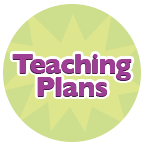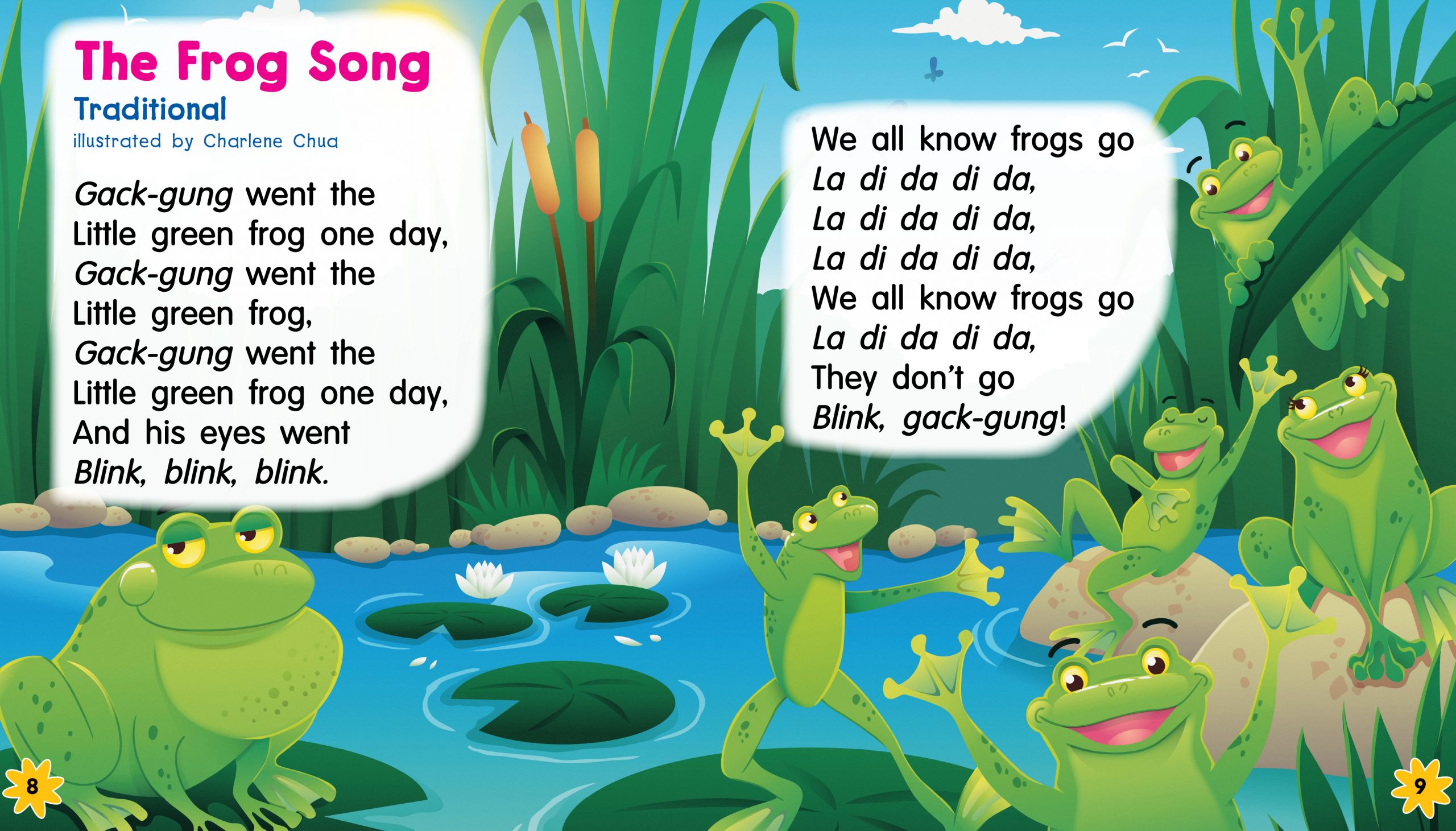Illustrated by Charlene Chua
Text Type: Fiction: Poetry—nonsense song/poem
Oral Language Teaching Strategy: Connect with the Student’s Message Listen and respond to the meaning behind the student’s communication.
Time: 20 minutes
Materials:
– All Together Now, pages 8–9
– Frog puppet
– Media Key or Online: “The Frog Song” audio
Grouping: whole class and partners
Assessment: Kindergarten Oral Language Assessment Scale See especially the section on Phonological and Phonemic Awareness.
FIRST READING
BEFORE SINGING AND READING
- Show the students the double-page illustration that accompanies the song.
-
Hello, I’m a frog who lives in this pond. I’m going to share a silly song with you that frogs in our pond like to sing.
Wear the frog puppet and use the puppet to introduce and accompany the lesson. Introduce the topic with the puppet and let it peep over the top or around the side of the big book.
Activating and Building Background Knowledge
-
Frog puppet: So you can see where I live. What do ou think of my home? is it like yours?
Use the puppet to ask the students what they know about frogs, and use the illustrations to stimulate ideas. Have students discuss their ideas with an elbow partner and then ask some students to share their ideas with the class. [Evaluating/making connections]
- As you listen to the students discuss with a partner and share ideas with the class, clarify if meaning is unclear and respond to the student’s message intent.
Kayla: I can’t swim!
Teacher: So are you thinking that my home in the pond isn’t a good home for you? Why is your home better?
Setting a Purpose
-
Join in singing with me and the other frogs as soon as you like. As you sing, think about why my frog friends sing this song.
Use the frog puppet to explain to students that they should listen to the song and join in as soon as they like. Ask them to think about why the frogs sing this song. [Inferring/synthesizing]
DURING SINGING AND READING
- Play the song and use the puppet to encourage singing along, especially when the song is sung a second time and the chorus is repeated.
- Focus on comprehension by offering prompts:
- What sounds do the frogs make? [Analyzing/inferring]
- Do they all agree about the kinds of sounds they make? Why do you think that? [Synthesizing/evaluating]
- What do you think they feel like when they sing this song? [Inferring]
- Focus on clarifying meaning and understanding each student’s intended message during discussions. Consider offering a structured framework to help the student clarify.
Mike: They feel not sad?
Teacher: So you think when they sing they feel happy? -
Replay the song and track the print in the big book. As you replay, clap to
the rhythm of the song and encourage the students to join in. [Phonological awareness] -
Read the song, tracking the print in the big book. Ask the students to clap to hear each segment of ‘la-di-da-di-da’ and each word in ‘Blink, blink, blink.’ [Phonological awareness]
Adding Playful Movements
- Replay the song and teach students the actions:
Gack-gung went the little green frog one day…
(arms akimbo, do a half-squat on each gack-gung)
And his eyes went blink, blink, blink
(blink eyes, but also open and shut hands beside eyes with each blink, for emphasis)
We all know frogs go la di da di da…
(twirl around with one arm akimbo and the other bent over the head in a goofy ballet imitation)
they don’t go blink, gack-gung!
(exaggerated blink plus gack-gung motion)
AFTER SINGING AND READING
-
So why do you think my frog friends sing this song?
Revisit the purpose for singing and reading by using the puppet to ask students why they think the frogs sang this song. [Inferring/synthesizing]
- You may wish to conclude the lesson by re-singing the song with actions and asking a student to wear the frog puppet to encourage participation.
SECOND AND FURTHER READING
The students will want to reread and re-sing “The Frog Song.” During further lessons, consider including a balance of ideas from the following areas:
Engaging in Playful Language Activities
- Sing the song in two parts so that half the class sings the first verse and the other half replies by singing the second verse.
- Sing the song while doing frog-like leaps in the gym and ask students to leap from one lily pad to another (hoops on the floor).
Extending Comprehension
- Use the frog puppet to ask the students how the song would sound if the frogs were sad. Students can discuss this with a partner and then share ideas with the class. Students can sing the song as sad frogs. One student can use the puppet to model how a sad frog would feel and act as the song is sung. Contrast by singing the song as happy, fun-loving frogs afterwards. [Making connections: comparing]
-
I’m a little grey cat and I’d like to be in the song. What sound would I make? Instead of “little green frog” we could say…?
Ask students how the song would sound if you substituted the frog for another animal. Chart the song and substitute the other animal, e.g., a little grey cat. Use the cat puppet to demonstrate.
- Display the digital cloze version of the text on the Media Key. Working with the whole class, or with a small group, reread together and encourage students to supply the missing words (spaces for words highlighted in yellow). You may decide to pause to consider word predictions and prompt, “Does that make sense?” or “Does that sound right?” Then click on the colour-highlighted spot to reveal the word, saying, “Let’s check that out.” An option on the tool bar allows you to create your own cloze versions of the text to meet the needs of the students you are working with. Click on the ‘Help’ button to find out how to use the different features of the digital texts.
Developing Phonological Awareness
- Use percussion instruments (e.g., drums, tambourines, sticks, rattles) to beat out the rhythm of the language and music.
- Substitute initial sounds that the frogs make, e.g., instead of ‘gack-gung,’ try ‘back-bung,’ ‘mack-mung,’ or ‘sack-sung.’
- Do oral rhyming for ‘frog’ (e.g., ‘log,’ ‘dog,’ ‘bog,’ ‘fog,’ ‘cog,’ ‘hog’), or ‘day’ (e.g., ‘bay,’ ‘day,’ ‘gay,’ ‘hay,’ ‘may,’ ‘pay,’ ‘ray,’ ‘say,’ ‘way’).
Enriching Print Concepts
- Track the print as you read and reread the song (and when you sing it). Emphasize movement onto a new line. You can use the frog puppet to
reinforce line movement.
- As the song becomes more familiar, ask the students to take turns in tracking the print.
- Emphasize the concept of ‘word’ by asking the students to clap for each word or to make an action for each word, e.g., the actions for ‘Blink, blink, blink’ will be made three times to represent the three words.
- Use a word frame (e.g., a Wikki Stix bent around the word, a cut-out cardboard frame, or a piece of coloured acetate) and look at selected words such as ‘frog,’ ‘green,’ and ‘the.’ Clap the numbers of letters in each word. (Concept: A word is made-up of letters.)
- Look at the capital and small ‘Gg’ in ‘Gack-gung’ and the capital and small ‘Bb’ in ‘Blink, blink.’
FOLLOW-UP IN CENTRES
- Place the frog puppet and the big book at a centre and encourage the students to reread the song. Use the fluent reading provided on the Media Key or online to support students as they reread.
- Students can also re-sing the song with the puppet, using the song version. Ask them to substitute other animals by selecting other puppets and changing the words, e.g., “Cluck-cluck went the little white hen one day.”
- You could include brightly illustrated books on frogs in the library corner, e.g., Red-eyed Tree Frog by Joy Cowley. Encourage students to share their findings and interesting illustrations with other students.
- Students can paint pictures of frogs or make frog sculptures using modelling clay. These can be shared and discussed with classmates during sharing time.

